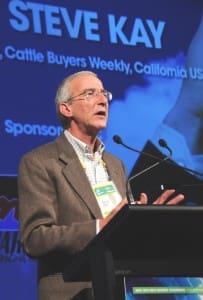 A monthly column written for Beef Central by US meat and livestock industry commentator Steve Kay, publisher of US Cattle Buyers Weekly
A monthly column written for Beef Central by US meat and livestock industry commentator Steve Kay, publisher of US Cattle Buyers Weekly
BEEF processing capacity and plant capacity utilisation are two different subjects – so I have been fascinated in recent weeks how some in the US beef industry have equated the two.
Their argument is that temporary plant closures and slowdowns seen in the US processing industry in April and early May (and to a lesser extent, in Australia) revealed that the industry needs a lot more capacity, mostly through new plants.
The COVID-19 pandemic did indeed cause massive disruptions to US beef plant operations. Weekly slaughter level reached a record low of 438,614 head the week ended May 2. This was 64pc of available capacity, using a maximum capacity of 685,000 head per week. But slaughter levels improved dramatically after that, returning by the end of June to normal levels.
This did not stop some people from insisting that the US industry needs more processing capacity. Several state governments went so far as to offer financial inducements to individuals or companies to build new, small plants in their state. Nowhere, however, did they mention that they would also ease the path through the thicket of planning, environmental and other regulations required just to get approval for a plant site.
Then in early October, Rabobank released a report that claimed that additional US daily packing capacity of 5000 to 6000 head of grainfed cattle could restore the historical balance of fed cattle supplies and packing capacity and still allow for positive packer margins. So argued Rabobank analyst Dustin Aherin in a report entitled The Case for Capacity.
Producers expand or contract their herd for two main reasons: profits or losses, or green grass or drought
Technology offers the best solution for existing plants to add capacity while smaller to medium, 1000 to 2000-head operations, make the most sense for adding capacity through new construction, he wrote. It is likely that additional US beef packing capacity will come from both sources, as recent profitability, an evolving labor environment, improved export market access and consumer-driven product differentiation have combined to present the greatest opportunity for innovative expansion in decades, he wrote.
Aherin’s report, however, offers no examples of when packing plant capacity encouraged US cow-calf producers to expand their herds. Had he asked me, I would have told him that producers expand or contract their herd for two main reasons: profits or losses, green grass or drought.
Aherin does admit that cost serves as a tremendous hurdle to increased capacity. Industry sources estimate the cost of a new processing facility at US$100 million to US$120 million per 1000 head of daily capacity, he wrote. Once a new plant exists and becomes ready to process, the capital to maintain through the first cattle cycle alone makes would-be investors wary, he added.
Spurred by the Rabobank report, prominent North American market analyst Kevin Grier set out to analyse the question of the balance between the US supply of grainfed cattle and fed beef processing capacity. These were his conclusions.
Balance might start to appear by 2022. This will be due to the combination of increased capacity and a US beef herd reduction. But US cattle feeders cannot be expected to gain any leverage until then. Given a likely decline in the herd, this leverage might turn solidly in cattle feeders’ favour by 2023.
From the perspective of cattle feeders, at the very least it means that there is still tough going in 2021. Furthermore, it also means that one path that is certain to get to a stronger leverage in 2023, is through a rationalisation from 2021-22.
The real question is when and how there will be the historical balance, says Grier.
Based on my annual listing of US packers in Cattle Buyers Weekly*, the top 30 companies in the US had a maximum daily slaughter capacity of 126,400 head in 2019, says Grier. It is likely modestly higher in 2020.
With the addition of new plants and expansion, the US industry should be at about 128,000 head by 2022. Even with this expansion and organic growth, capacity will be much less than ten or more years ago. There was serious US plant rationalisation in the 2012-2014 period, which saw notable closures by Tyson Foods, Cargill and National Beef Packing, he says.
Grier notes that CBW’s Top 30 listing is for all cattle, not just fed cattle. Taking 80pc of the Top 30 total can be used as a gauge for fed cattle slaughter capacity, he says.
The next step is to examine capacity against fed cattle supplies. The ratio of steer and heifer inventory January 1 compared to the annual Top 30 slaughter capacity from 2010 to 2017 was about 97pc. That means that fed cattle supplies to start the year were about 3pc less than annual capacity. The ratio of the inventory to capacity in 2018-2020 was 102pc, he says.
Grier expects to see steer and heifer inventory down about 3pc in 2022 from the January 2020 total. Coupled with the increase in capacity at two existing companies (Agri Beef and FPL Food), this should get that supply-capacity ratio down to 98pc, he says.
Grier’s analysis thus suggests that the balance between supply and capacity fluctuates according to the US cattle cycle of expansion and contraction, and is not the issue that some think it is.
* Cattle Buyers’ Weekly’s annual Top 30 US Packers analysis is an excellent industry resource compiled each year since 1999– editor
